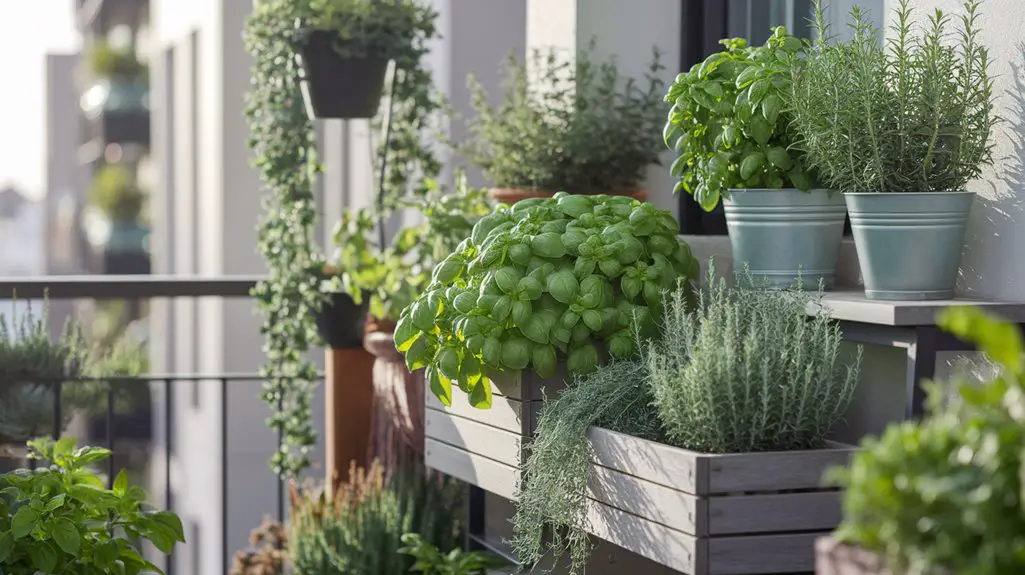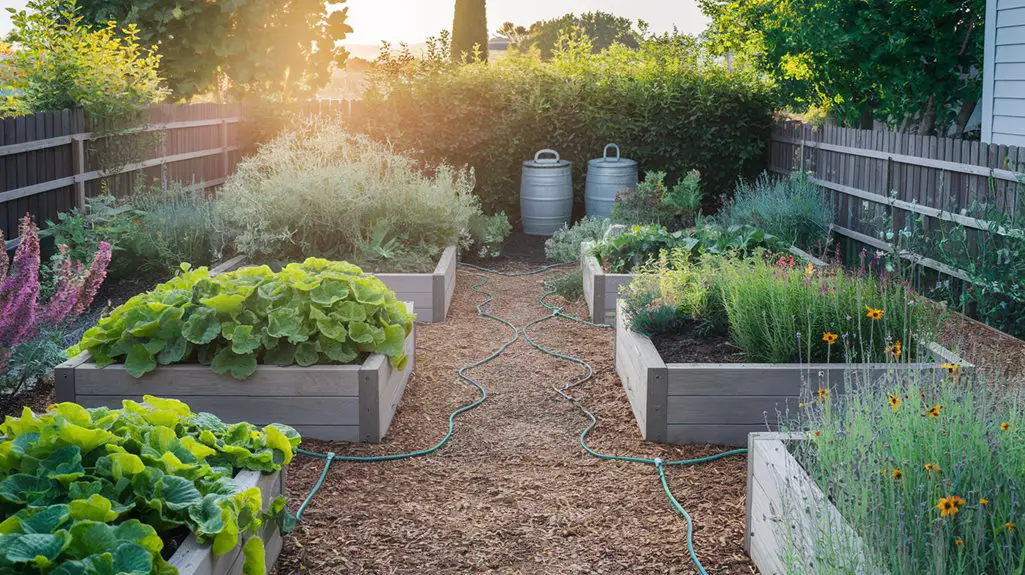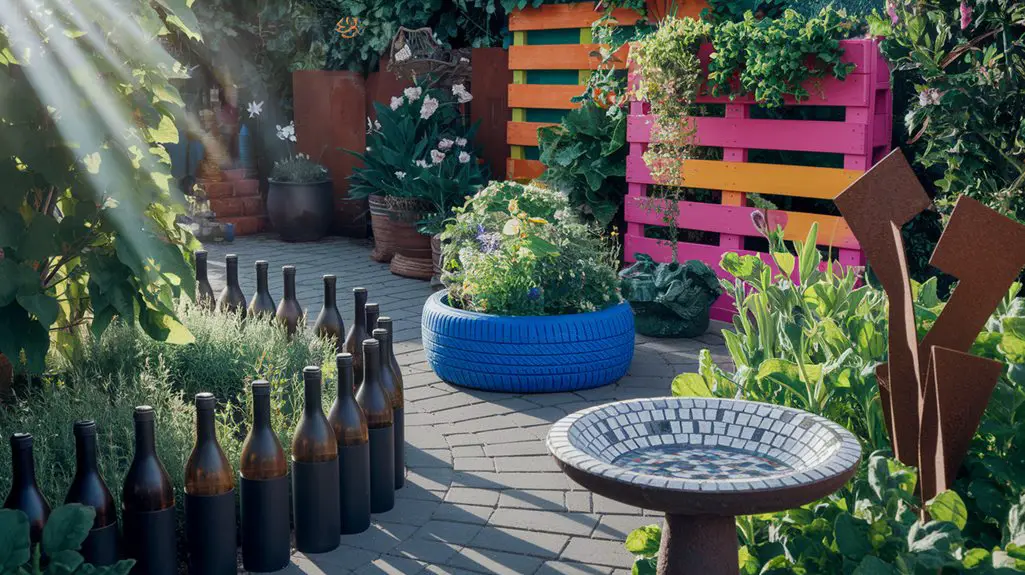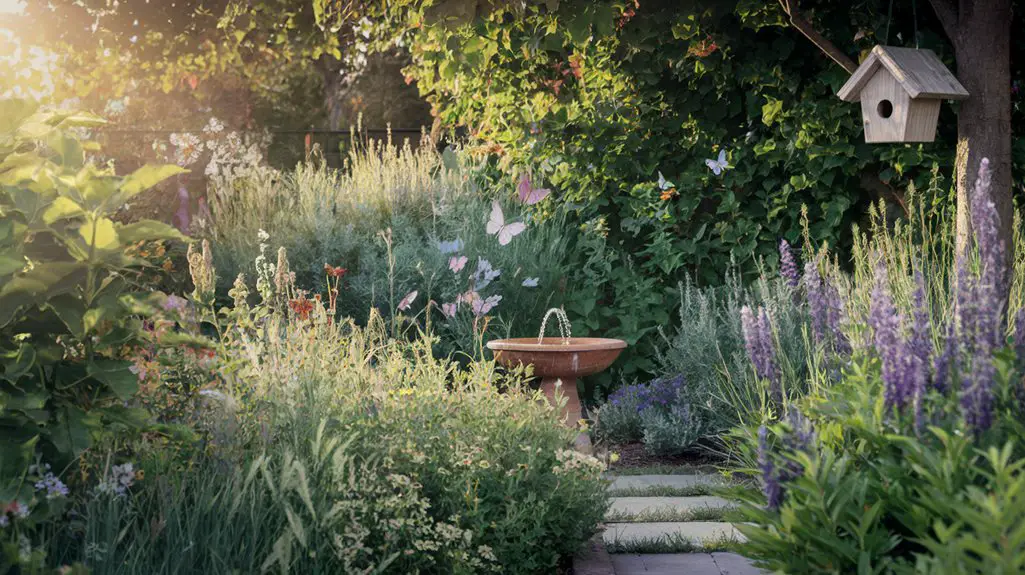Don't let your small apartment stop you from growing fresh herbs. You'll find that with a bit of creativity, your compact living space can transform into a mini culinary garden. Whether you're working with a blank wall, a sunny windowsill, or just a small tabletop, there's a space-efficient solution that fits your needs. Discover how urban dwellers are bringing nature indoors while saving money and reducing their environmental footprint with these clever herb garden approaches.
Vertical Wall Herb Gardens for Limited Floor Space
Space constraints shouldn't limit your culinary herb adventures. Vertical wall gardens transform blank apartment walls into thriving herb havens while preserving precious floor space.
Mount a grid panel or repurpose a shoe organizer to create tiers of potted herbs that climb rather than sprawl.
Choose wall spots that receive 4-6 hours of sunlight daily—typically south or west-facing windows work best. Install waterproof backing or use drip trays to protect your walls from moisture damage.
For rental-friendly options, try tension rods with hanging planters or freestanding vertical systems that lean against walls without permanent fixtures.
Arrange herbs according to water needs: place moisture-loving basil and mint at the bottom, drought-tolerant rosemary and thyme up top. Additionally, consider optimal spots for your raised garden beds to ensure your herbs thrive in their vertical environment.
This vertical arrangement not only maximizes growing space but creates a living wall of fragrant, functional greenery.
Windowsill Herb Container Systems
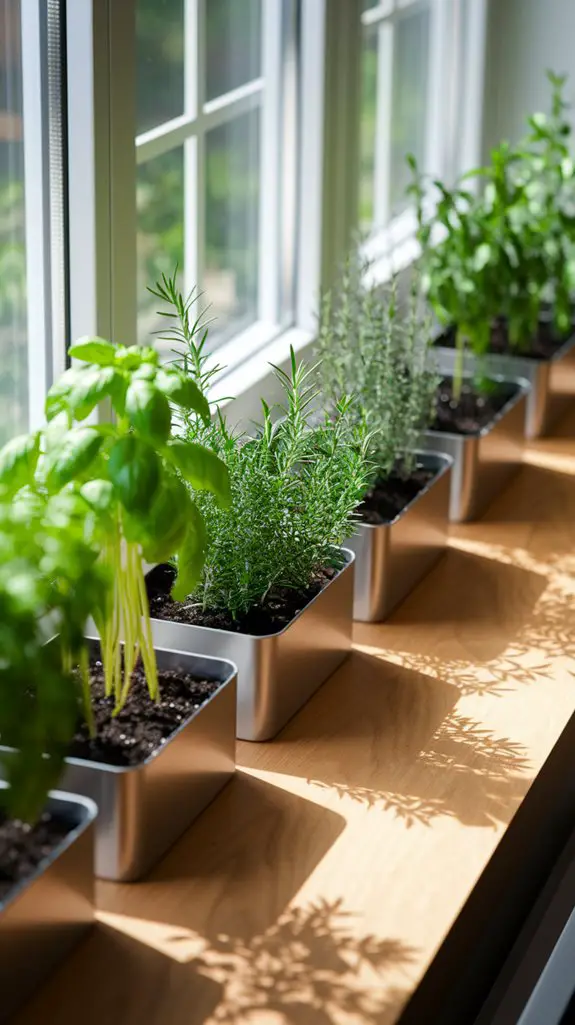
Windowsills offer the ideal urban real estate for compact herb gardens, functioning as nature's designated growing shelves in even the tiniest apartments. You'll want containers that maximize this narrow space while providing proper drainage and sunlight access for your culinary companions.
| Container Type | Benefits | Best For |
|---|---|---|
| Rail Planters | Hang outside window, save interior space | Trailing herbs like thyme, oregano |
| Tiered Stands | Vertical growth, multiple herbs | Mixed herb collections |
| Self-Watering Pots | Reduced maintenance, consistent moisture | Basil, mint, cilantro |
Choose containers that complement your window size—narrow railing planters for slim ledges or deeper pots where space permits. Clear containers let you monitor soil moisture, while terracotta regulates temperature naturally. Remember that south-facing windows provide ideal light for most Mediterranean herbs like rosemary and sage. Additionally, incorporating raised bed herb gardens can inspire your urban gardening efforts even in small spaces.
Hanging Herb Planters for Kitchen Areas

When kitchen countertop real estate comes at a premium, hanging herb planters transform unused vertical space into productive growing zones without sacrificing your meal prep area.
You'll maximize your apartment's growing potential by suspending herbs from ceiling hooks, tension rods, or even repurposed towel racks mounted above windows.
- Macramé herb hangers add bohemian flair while keeping basil, mint, and thyme within arm's reach.
- Repurposed rain gutters mounted horizontally create sleek, modern herb channels perfect for shallow-rooted varieties.
- Magnetic planters that stick to refrigerators utilize otherwise wasted space.
- Multi-tiered hanging systems grow upward not outward, letting you cultivate 3-4 times more herbs in the same footprint.
When selecting herbs, consider shady backyard areas that thrive even with limited sunlight exposure.
Choose planters with built-in drainage protection to prevent water damage to your floors and furnishings below.
Repurposed Household Items as Herb Gardens

Before heading to the store for expensive herb containers, take a fresh look at everyday household items that can be transformed into creative, budget-friendly herb gardens. Old tea tins, mason jars, and wooden crates make perfect vessels for herbs like basil and mint.
That chipped teacup? Drill a drainage hole and plant some thyme. Empty wine bottles can be cut horizontally and used as self-watering planters.
Even an old shoe organizer can become a vertical herb garden when hung against a sunny wall. Remember to sanitize containers thoroughly and guarantee proper drainage.
Coffee cans work well for larger herbs like rosemary, while egg cartons make excellent seed starters. Additionally, using vertical gardening techniques can help maximize small space gardening opportunities in your apartment. Your apartment's footprint stays small while your sustainability impact grows large—all without spending a fortune.
Stackable Herb Garden Towers

Stackable herb towers maximize this dimension by allowing you to grow multiple herbs in a compact footprint.
These systems typically feature modular pots or trays that lock together, creating a tower of greenery that reaches upward rather than outward.
- Choose self-watering towers where lower plants receive runoff from upper levels
- Look for rotating designs that guarantee all plants receive adequate sunlight
- Select lightweight materials like recycled plastic for balcony-safe installation
- Opt for expandable systems that grow with your herb collection
Incorporating companion planting techniques can further enhance the growth and flavor of your herbs. You'll find these space-efficient gardens particularly useful for herbs with similar water needs, creating microclimates that benefit multiple plants while using minimal resources in your urban sanctuary.
Magnetic and Adhesive Herb Gardens for Cabinet Sides
Kitchen cabinets, those overlooked vertical surfaces, offer prime planting real estate in apartment living. By attaching magnetic planters or adhesive pouches to these spaces, you'll transform dead zones into thriving herb havens without sacrificing counter space.
Choose lightweight containers with strong magnets for metal cabinets, or reliable adhesive options for wood or laminate surfaces. Look for systems that incorporate water-catching features to prevent kitchen damage. Many modern designs include removable plant cups that let you water herbs in the sink.
For maximum visibility and kitchen efficiency, arrange herbs by usage frequency—keeping basil, parsley and mint at eye level. This vertical gardening approach puts fresh flavors within arm's reach while creating a living wall that adds vibrant greenery to your compact kitchen ecosystem.
Tabletop Hydroponic Herb Systems
Three revolutionary options have transformed apartment herb gardening: tabletop hydroponic systems. These soilless wonders use nutrient-rich water solutions to grow herbs faster than traditional methods, while occupying minimal counter space.
You'll enjoy fresh herbs year-round without the mess of soil or the guesswork of proper watering.
- Smart systems with built-in LED grow lights adjust automatically to your herbs' growth phases
- Water-efficient designs use up to 95% less water than conventional gardening
- Self-contained units eliminate pest problems common in soil gardens
- Stackable configurations maximize vertical space for growing multiple herb varieties
Most systems come ready to use with seed pods, nutrients, and simple instructions.
Your compact kitchen can become a productive growing space regardless of natural light conditions or outdoor access. Additionally, these systems promote eco-friendly vertical gardening by reducing the need for pesticides and fertilizers.
Conclusion
Whether you transform your walls, dress your windowsills, or hang herbs from above, apartment gardening is all about ingenuity. You'll save space, money, and trips to the store while bringing nature into your urban sanctuary. Start small, grow upward, and think creatively—your compact oasis awaits. Remember: in city living, every inch counts, every herb thrives, and every green addition matters to both your meals and the planet.

